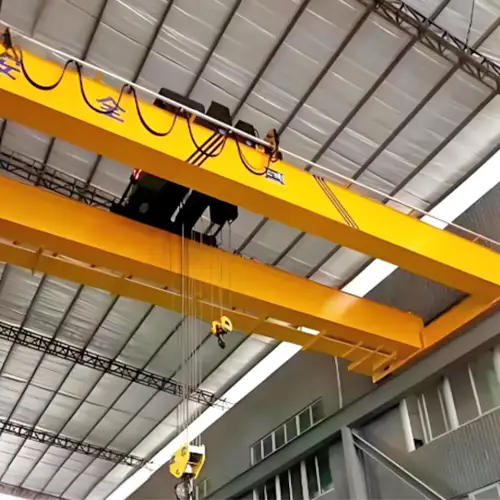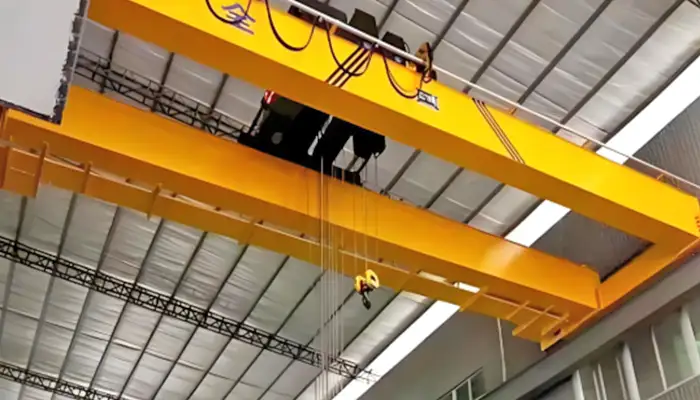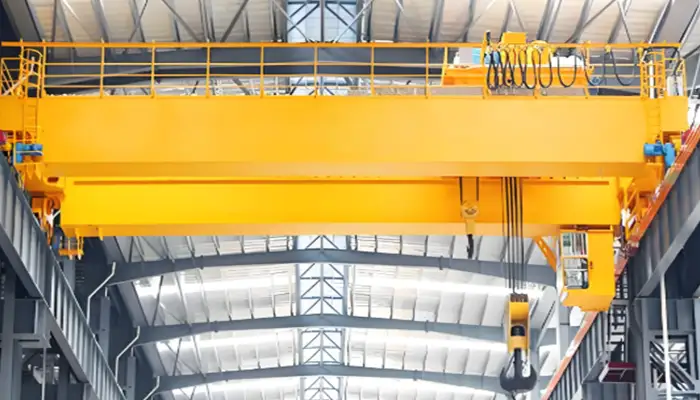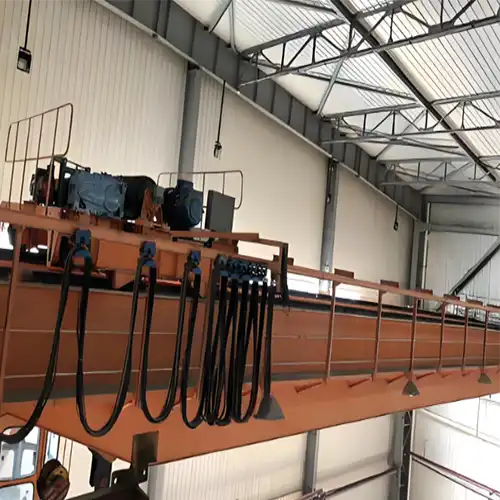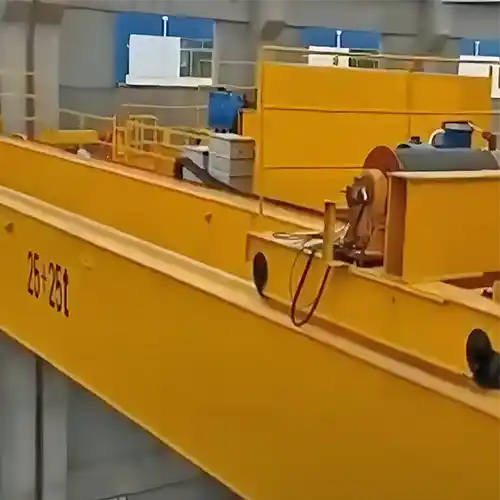What Does a 50 Ton Overhead Crane Really Cost?
50 /10 ton overhead crane for sale. Detailed specs and dimensions for open winch double girder cranes with 50/10 ton capacity, ideal for heavy lifting.
Category: Featured
Your Trusted Overhead Crane Manufacturer & Supplier
What Does a 50 Ton Overhead Crane Really Cost?
A Buyer's Cost & Risk Checklist
The True Cost of a 50 Ton Overhead Crane Is More Than the Price Tag
When it comes to buying a 50 ton overhead crane, many buyers focus too quickly on the crane's selling price. That's understandable—after all, it's a major upfront investment. But if you're only budgeting for the crane itself, you're not seeing the full picture.
The actual cost includes a number of essential elements beyond the equipment: freight, installation, electrical work, spare parts, and more. Skipping these considerations early on can lead to unexpected expenses later—and delays you didn't plan for.
Why Buyers Often Miss the Real Numbers
In many projects, the biggest budgeting problems happen not because buyers make bad decisions, but because they overlook the details. Overhead crane costs vary based on site layout, working environment, lifting frequency, and whether local teams can handle parts like runway beam installation or electrical wiring.
Here's where it usually goes wrong:
- Underestimating freight and customs: International shipping isn't just about distance—it depends on crane size, port charges, and insurance too.
- Missing installation readiness: You may need extra work on foundations, power supply, or even ceiling reinforcement, especially in existing workshops.
- Forgetting long-term maintenance: Some components wear faster than others; budgeting only for now means you'll struggle with future downtime and repair bills.
What This Checklist Will Help You Do
This article is written for crane buyers who want to stay in control of both costs and risks—from day one until years into operation. It offers a clear, organized checklist that breaks down:
- What you're actually paying for when you buy a 50 ton crane
- Which costs are hidden or show up later in the project
- What risks can impact your budget, safety, and installation timeline
- What practical steps to take before signing any contract
Think of it as a guide you can use when talking to suppliers, budgeting with your team, or comparing offers. Whether you're replacing an old unit or setting up a new plant, it's better to ask the right questions now than to pay more later.
Key Cost Components of a 50 Ton Overhead Crane
To properly budget for a 50 ton overhead crane, it's not enough to look at the base price. A complete cost breakdown includes everything from delivery to installation and even taxes. Here's a closer look at the key components that make up the total cost.
Crane Purchase Price
This is the most visible part of the expense—and where most buyers start. The base purchase price usually includes the crane girders, trolley, 50 ton hoist, electrical system, and controls. However, depending on the manufacturer and design, prices can vary significantly.
- Design type plays a big role. An open winch crane typically costs less than a European-style crane with compact design, inverter drives, or smart functions.
- Add-ons such as radio control, cabin control, variable speed drive systems, or anti-sway technology will increase the total price.
- Higher-duty cranes built for heavy and frequent lifting (like FEM 3m or ISO A5-A6) are more expensive due to their enhanced durability.
- The origin of the crane affects the price. Chinese-made cranes often cost less than European or American brands, though certifications and after-sales support should be compared too.
Practical tip: Don't settle for a lump-sum offer. Ask for a line-by-line technical quote that shows what is included and what is not—like rails, runway beams, or power cables.
Freight and Shipping Costs
Shipping a 50 ton overhead crane is a job in itself. Most components are too large or heavy for standard containers, which means freight planning needs attention early on.
- FOB (Free On Board) pricing means you arrange shipping and insurance after the crane is loaded at the origin port.
- CIF (Cost, Insurance, and Freight) pricing includes sea freight and marine insurance to your destination port. It simplifies logistics, but may cost a bit more upfront.
- Large cranes are often shipped using flat racks or breakbulk vessels, depending on the size of the main beams and hoisting unit.
- Port handling, container loading fees, and marine insurance all contribute to the final logistics cost.
Practical tip: If your facility is far from a port or in a remote location, factor in local trucking costs. These can add up quickly and may require special handling permits.
Customs Duties and Taxes
Crane buyers sometimes forget to include customs-related costs in their overall budget. But depending on the country, these fees can be considerable.
- Each country has its own import tariff for overhead cranes. This is usually determined by the crane's HS Code (e.g., 8426.11), and the country of origin may affect the duty rate.
- Value Added Tax (VAT), sales tax, or import levies may apply. In some cases, businesses can reclaim VAT, but the process can be slow or restricted.
- Customs clearance involves documentation such as the commercial invoice, packing list, certificate of origin, and technical certifications like CE or ISO.
- Additional fees like customs inspection charges, terminal handling fees, or warehousing costs may also apply if the shipment is delayed or held.
Practical tip: Consult with a freight forwarder or customs agent who has experience importing industrial equipment. They can guide you through local requirements and prevent clearance delays.
Installation and Commissioning
Getting a 50 ton overhead crane delivered is just one part of the job. Turning that crane into a fully functional lifting system at your site involves several other steps—each with its own cost.
Site Preparation Costs
Before installation starts, the site must be prepared to safely support and operate a crane of this size. This often requires construction or reinforcement work, which varies depending on your facility's existing conditions.
- Runway beams must be installed, aligned, and structurally anchored. If your facility doesn't already have them, this is a major added cost.
- Foundations for columns or brackets may be needed, especially for newly built or upgraded workshops.
- Building height and clearance need to be checked carefully—low ceilings or obstacles can affect both installation method and crane design.
A miscalculation in this phase can cause delays and unexpected rework, so it's important to do a proper site inspection before finalizing crane specs.
Labor and Technical Supervision
Once the crane components arrive on-site, assembling them isn't just a matter of plugging things in. Skilled technicians, rigging teams, and sometimes even specialized installation tools are required.
- Local labor can handle some of the mechanical work, but supplier supervision or certified technicians are often necessary for tasks like electrical wiring, hoist assembly, and final calibration.
- Costs can include travel, accommodation, and daily supervision fees for technicians from the crane supplier or an authorized service partner.
- Additional manpower may be required for equipment like scaffolding, lifting gear, or mobile cranes to assemble large girders and trolleys.
Don't assume installation is a fixed cost—it changes based on site conditions, crane type, and local labor availability.
Testing and Certification
Before you can legally or safely operate the crane, it needs to be tested and, in most regions, certified by an approved inspector.
- Load testing using certified weights must be performed to validate lifting capacity and safety functions.
- Depending on your location, a government or third-party body may need to certify the crane before it can be commissioned.
- If your country has occupational safety laws (such as OSHA in the U.S. or local equivalents), full documentation must be submitted for approval.
Some suppliers include testing and commissioning in their quotation—others charge separately. Always confirm.
Electrical and Control Systems
Many buyers overlook the cost and complexity of electrical setup, but it can become one of the most sensitive parts of the installation.
Power Supply Compatibility and Modifications
Cranes need stable power, and the supply at your facility must match the crane's design. If not, adjustments will be necessary.
- Most industrial cranes operate on 380–415V, 3-phase, 50/60Hz. If your site uses a different voltage or frequency, transformers or other electrical modifications may be needed.
- Long distances between your control cabinet and power source can increase wiring and cable tray costs.
- Motor protection, power disconnects, and grounding systems must meet local electrical codes.
It's best to review this with both your crane supplier and your site's electrical contractor before installation begins.
Control System Type and Safety Features
Crane control systems come in several types—each with different costs, safety levels, and usability.
- Standard pendant control is usually the cheapest but may be inconvenient for large or busy workspaces.
- Radio remote control adds flexibility and safety but costs more.
- Cabin control may be required for long runways or high-precision handling, especially in steel plants or heavy manufacturing.
Also consider the safety devices included, such as emergency stop buttons, travel limit switches, overload protection, and anti-collision sensors if you have multiple cranes.
Make sure the electrical layout is compliant with both your country's standards and your site's safety policies.
Training and Operator Certification
Even the best crane won't help if your operators don't know how to use it safely and efficiently. Training is both a legal and operational necessity.
Initial Operator Training Costs
Suppliers often offer operator training as part of the commissioning process. It's essential that operators understand not just the controls, but also the limits of the crane and how to respond to fault signals.
- Basic operation, emergency procedures, and daily checks should be covered.
- In some industries, operators must pass a practical test and receive certification before using the crane.
Training may be on-site or at an external facility, depending on your location and crane model.
Ongoing Certification and Compliance Expenses
In many regions, crane operators must renew their licenses or undergo periodic retraining. If you operate in a regulated industry, you may also be required to keep maintenance logs and training records.
- Compliance audits may require evidence of operator training and certification.
- Safety refreshers or updated training may be needed if the crane is upgraded or relocated.
Don't leave training for last—plan for it early in the purchasing process and include it in your budget.
Maintenance and Spare Parts
Even the most robust 50 ton overhead crane needs upkeep. Skipping or delaying maintenance can lead to equipment failure, safety risks, and long downtimes. To avoid those issues, it's important to understand both the expected maintenance workload and the cost of keeping your crane in good shape.
Scheduled Maintenance Plans and Costs
Cranes of this size require regular inspection and servicing to stay in working order. Most manufacturers will recommend a maintenance schedule based on the crane's duty cycle and environment.
- Routine tasks include checking the hoist brakes, gearbox oil levels, wheel wear, wire rope condition, and control panels.
- For a crane running daily, especially in a steel or heavy fabrication plant, monthly or quarterly inspections are typically required.
- Annual inspections, often by a certified third-party agency, may be legally required depending on your region.
- If you don't have in-house maintenance staff, you'll need a service contract with a qualified local technician or crane company.
A planned service schedule reduces the risk of sudden breakdowns—but it also means you'll need to budget for ongoing labor and spare parts.
Availability and Cost of Spare Parts
Not all parts are equal when it comes to availability. Some components are standard and easy to source. Others, like custom gearboxes or European-designed frequency drives, can take weeks to deliver.
- Common wear parts include contactors, brake pads, wheel sets, limit switches, and wire ropes.
- For critical operations, it's wise to keep a small inventory of fast-moving parts on-site.
- Prices vary by brand and country of origin. A hoist motor from a European supplier can cost two or three times more than a Chinese-made one.
- Always confirm whether the supplier provides local parts support or if all replacements must be imported.
Before purchase, ask your supplier for a recommended spare parts list and lead time estimates for critical components.
Warranty and Service Contracts
Crane buyers often focus on warranty length—but it's just as important to know what's actually covered and how support is provided.
Standard Warranty Coverage
Most manufacturers offer a one-year warranty on mechanical and electrical components, though this can vary slightly.
- Typically covers manufacturing defects in hoists, motors, gearboxes, and controls.
- Does not cover wear and tear items like wire ropes, brake pads, or fuses.
- Service under warranty may require proof of regular maintenance and correct operation.
- Some suppliers handle warranty claims directly, while others require coordination through an agent or local partner.
Read the fine print. A long warranty is no good if it's hard to claim or if service support is slow.
Extended Service Agreements and Associated Costs
If your crane will be a core part of your production line, it may be worth negotiating an extended service contract at the time of purchase.
- These often include periodic inspections, preventive maintenance, and priority service response.
- Some suppliers offer fixed-price service plans for 2 to 5 years, which can help you stabilize costs and avoid spikes from emergency repairs.
- Check if the supplier offers remote diagnostic support, which can be useful for control system troubleshooting.
Extended service can add 5% to 10% to the total crane cost—but can pay off if unplanned downtime is a serious concern in your operation.
Operational Costs
Beyond the upfront purchase, a 50 ton overhead crane creates ongoing operating costs—some obvious, some less so.
Energy Consumption
Large cranes, especially those with heavy-duty hoists or long travel distances, consume significant power.
- Power consumption depends on motor size, duty cycle, and lifting speed.
- Inverter-controlled motors are more energy-efficient but cost more upfront.
- If your facility has multiple cranes or limited supply, peak usage planning is worth considering.
Check with your electrical team whether your current power system can handle the crane's demand—upgrades can add hidden costs.
Downtime Risks and Productivity Impact
Unplanned downtime is one of the most expensive hidden costs in crane ownership. A failed motor or gearbox can stop an entire production line.
- Every hour of lost operation could result in missed deadlines, idle workers, or disrupted logistics.
- In industries like steel, automotive, or heavy machining, crane uptime is directly tied to output and profitability.
- Investing in reliable components and a fast-response service partner helps reduce these risks.
In short, owning a crane is not just about lifting heavy loads—it's about keeping your production moving without interruption.
Risks to Consider When Buying a 50 Ton Overhead Crane
Buying a 50 ton overhead crane is a serious investment, not only in money but also in operational reliability. While cost is a big part of the decision, risk often lies in the details. Missed specifications, supplier issues, and site conditions can quickly turn a good deal into an expensive problem. Below are the key risks every buyer should watch out for—and how to stay ahead of them.
Specification Mismatches
The most common and costly mistake in crane procurement is misjudging the actual lifting needs.
- If the crane is oversized, you've overpaid for capacity you don't use, and your operating costs will be higher than necessary.
- If it's undersized, your crane will wear out quickly—or worse, it won't be safe to operate under peak loads.
- Misjudging the crane span, lifting height, or duty class can lead to serious layout and performance issues.
Always confirm the heaviest load, frequency of use, and working environment. A few extra hours on detailed specification saves months of regret later.
Supplier Reliability and After-Sales Support
Even if the price looks good, the deal may fall apart if the supplier doesn't deliver on time—or doesn't pick up the phone when something goes wrong.
- Some suppliers may offer low prices but cut corners on steel, motors, or electrical components.
- If the supplier doesn't provide timely technical drawings, shipping updates, or installation guidance, your whole project could stall.
- After-sales support matters. If spare parts are hard to get or service is slow, downtime becomes a real risk.
Ask for references, review past projects, and check what kind of support network the supplier offers in your region.
Installation Challenges
Installing a 50 ton overhead crane isn't just a plug-and-play job. Site-specific issues can quickly make installation more expensive and time-consuming than expected.
- Uneven floor levels, lack of headroom, or outdated structural drawings can lead to delays or rework.
- If your workshop wasn't designed for a heavy crane, reinforcing columns, adding runway beams, or modifying electrical systems may be necessary.
- Unexpected clashes with lighting, HVAC, or sprinkler systems are more common than you think.
A pre-installation site inspection, preferably with a technician from the crane supplier or a local engineering partner, is highly recommended.
Regulatory Compliance Risks
Every country—and in some cases, every region—has its own safety and compliance rules for lifting equipment. If your crane doesn't meet these, it might never be allowed to operate.
- National safety codes (like OSHA, CE, or ISO standards) may require design verification, certification, or commissioning inspection.
- Control panels, limit switches, overload protection devices, and rail clamps all need to meet the local standard.
- In some countries, cranes must be tested and approved by a licensed third party before use.
If your supplier isn't familiar with your country's rules, you might end up modifying the crane after delivery—which adds cost and time.
Hidden Costs
Some crane quotations look affordable at first—but you later find out they didn't include everything.
- Power cables, crane rails, runway beams, or remote controls may be excluded from the quote.
- Special paint coatings, weatherproofing for outdoor use, or explosion-proof components may cost extra.
- If your site requires assembly under restricted space, extra labor or mobile cranes might be needed.
Be direct—ask for a detailed itemized offer. Know what's included and what's not. Don't assume anything.
Long-Term Operational Risks
A crane is a long-term asset. What seems reliable today can become a maintenance burden five years down the road if the parts are hard to replace or the design is outdated.
- Mechanical wear and electrical fatigue are normal, especially in high-cycle operations.
- Parts like wire ropes, brakes, and bearings need to be replaced periodically—some brands are easier to source than others.
- If the crane is custom-built with non-standard components, you may face long wait times for spares.
Also, consider the total cost of ownership. A slightly cheaper crane with high energy use and poor support can cost far more over its lifetime.
Checklist for Buyers: Managing Costs and Risks Effectively
Planning to buy a 50 ton overhead crane? The more groundwork you do upfront, the smoother your project will go—and the fewer financial surprises you'll face down the line. This checklist isn't just about saving money. It's about avoiding mistakes that lead to delays, breakdowns, and unnecessary stress.
Use this list as a guide to make sure you're covering all the key areas.
Define Clear Technical Specifications and Operating Conditions
Before you even request a quote, make sure you understand what you need the crane to do.
- What's the heaviest load the crane must lift—and how often?
- What is the required span, lifting height, and travel length?
- What's the working environment like—dusty, hot, corrosive, or clean and dry?
- Will the crane operate indoors or outdoors, and under what weather conditions?
Clear specs will help your supplier propose the right crane model, and not something over- or under-engineered.
Request Detailed Quotations Including All Cost Elements
Don't accept vague pricing. A reliable supplier will provide a full, itemized quotation.
- Ask for a complete breakdown: crane price, shipping, customs, installation, and optional features.
- Clarify whether runway beams, power cables, and control systems are included or quoted separately.
- Check whether the price is FOB, CIF, or includes delivery to your site.
This level of detail helps you compare offers and avoid hidden costs that show up after the crane is already ordered.
Verify Supplier Certifications, References, and Warranty Terms
Not all crane suppliers are equal—and once you place the order, you're committed. So check them out properly.
- Ask for CE, ISO, or other relevant certifications.
- Request client references, especially from similar industries or crane capacities.
- Understand the warranty period, what's covered, and how support is handled if there's an issue.
- Find out if the supplier offers local service support or remote guidance.
It's better to spend a little more with a proven supplier than to deal with delays, defects, or poor service.
Plan for Installation Logistics and Site Readiness
Don't wait until the crane arrives to start thinking about installation.
- Confirm your building structure, floor level, and ceiling clearance are suitable.
- Make sure power supply, runway beams, and site access are ready before delivery.
- Discuss installation responsibilities: Will the supplier send technicians? Who handles rigging, lifting, and commissioning?
Installation delays are common—avoid them by preparing the site early and coordinating closely with your team and supplier.
Include Training and Maintenance Plans in Budgeting
Even a perfectly installed crane is only as safe and effective as the people using it.
- Allocate time and budget for operator training during or after commissioning.
- Set up a maintenance plan—either in-house or with a local service provider.
- Keep funds aside for the first year of preventive inspections, especially for high-duty cranes.
Training and upkeep aren't optional. They directly affect your crane's lifespan and performance.
Consider Long-Term Operational Costs, Not Just Upfront Price
It's easy to compare prices—but don't forget what comes after the crane is installed.
- Higher efficiency motors and inverter drives may cost more upfront but save on power bills.
- More durable designs last longer and reduce downtime.
- Ease of maintenance and part availability directly affect long-term cost.
Ask suppliers for estimated total cost of ownership over 5–10 years, not just day-one cost.
Prepare Contingency Budget for Unexpected Expenses
Even with perfect planning, things happen. Cranes are large, complex systems—and no two installations are ever exactly the same.
- Unexpected customs fees, small civil work changes, or extra accessories often pop up during the project.
- Freight costs can change based on port availability or fuel surcharges.
- On-site installation conditions may require added equipment or labor.
Setting aside a 5% to 10% contingency helps you stay on track without last-minute scrambling.
Conclusion
Buying a 50 ton overhead crane isn't just about choosing the right equipment—it's about planning for the full picture. From the moment you request a quote to the day the crane is running in your workshop, every step involves cost and risk factors that can affect your project timeline, safety, and budget.
We've covered the major components: equipment pricing, freight, installation, power setup, maintenance, training, and operational costs. We've also walked through the key risks—from under-specifying your crane to overlooking long-term service support. These are the kinds of issues that can quietly drain time and money if not handled early.
What makes the biggest difference is how well you prepare. Buyers who take the time to gather accurate specs, ask detailed questions, and involve experienced partners usually get better results. They avoid delays, minimize unexpected costs, and end up with a crane that performs reliably for years.
So before you make a final decision:
- Double-check your specs.
- Talk to more than one supplier.
- Get a complete quotation.
- Make sure your site is truly ready.
And don't hesitate to ask for help. A reputable supplier with experience in 50 ton cranes can guide you through every phase—from design and delivery to training and service.
A little extra effort now can save you months of frustration later.
Related Products
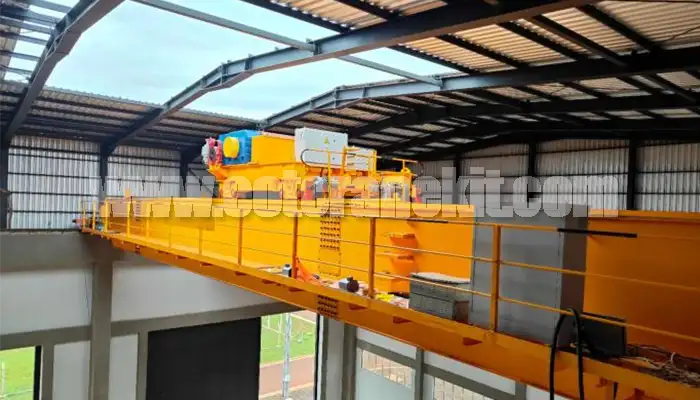
Latest project
150 Ton Overhead Crane Installation Feedback – Paraguay Case
QDX 150 ton overhead crane in action in Paraguay. Installation photos, video, and client feedback show performance, safety, and heavy-lifting efficiency.
Free consultation to Confirm Parameters & Specifications and Get
Latest Crane Price & Crane Rate.
- Types of overhead cranes : _______?
- Optional: Overhead travelling crane, goliath gantry crane,Slewing jib crane, Single girder or double girder crane,small portable crane or kbk crane, etc.
- Capacity of overhead crane: _______?
- Optional: 0.25ton, 0.5 ton, 1 ton, 2 ton, 3ton, 5 ton, 10 ton,15ton, 20ton, 25 ton, 30ton,35ton, up to 550ton, etc.
- Crane span & lifting height : _______?
- Crane travelling length : _____?
- Control of overhead crane:_______?
- Optional: pendant/ remote/cabin control
- Voltage supply of overhead crane:_____?
- Eg,: 380V50/60HZ,3Phase or others,etc.
- Application/usage of crane:_______?
- Eg,: Steel mill, ,injection mold, cement,stone, concrete,granite, general manufacturing, etc.
Just leave a message via the contact form and our hoist and crane engineer will contact you with in 24working hours.
Get In Touch
